The purpose of the Joint Strategic Needs Assessment (JSNA) is to provide an objective view across the life course from cradle to grave, of the health and wellbeing needs and inequalities of a local population. Therefore a local JSNA can illustrate the challenges affecting different populations at different stages of their lives, and provide an evidence base for the services commissioners need to commission, to meet the needs of the population.
- South Devon and Torbay Joint Strategic Needs Assessment
- Devon County Council Joint Strategic Needs Assessment
Key points from the current (2020/21) JSNA are:
- The recovery from COVID-19 and the cost of living The social and economic effects of the pandemic and the inflationary leaps in the cost of living, particularly around gas, electricity and food prices have disproportionately affected those who live in the most deprived areas of our communities. Costs around fuel are exacerbated by old housing stock which is often energy inefficient.
- There is significant variation in health and wellbeing across the bay. In our most affluent areas residents can expect to live on average over eight years longer than those living in our more deprived communities. There are also significant gaps in healthy life expectancy between the most affluent and deprived areas.
- Inequalities have been widening as relative deprivation worsens; Torbay is ranked as the most deprived local authority in the South West.
- Torbay’s economy is ranked among the weakest in England. Average wages continue to be significantly below the regional and national average with less of the population in full-time employment than England.
- The number of cared for children within the local authority remains among the highest in Rate of referrals to children’s social care are consistently much higher than England.
- Torbay schools have a significantly higher proportion of their pupils requiring special education needs support through an Education, Health & Care Plan when compared to England.
- Persistent absenteeism from school doubled in 2021/22. This is reflected across England.
- Torbay has far higher levels of need when compared to England that requires support from Adult Social Care in the 18 to 64 population. Rates of requests from new clients are much higher than England in the 18 to 64 and 65+
- The 2021 Census showed that there were 14,900 unpaid carers in 5,185 of these provided 50 hours or more of care. These unpaid carers require support to help deliver this care and to look after their own health and wellbeing. This care is disproportionately provided by women.
- We have an ageing population with 1 in 3 Torbay residents expected to be 65 and over by the middle of the next The number of those who are of working age is projected to fall over the next 20 years to approximately 50% of the population from its current rate of 55%.
- Consistently high rates of dental extractions among children performed at a hospital due to dental decay; this is particularly concentrated among Torbay’s more deprived communities.
- There are many opportunities for the people of Torbay to be supported to improve their lifestyles. At present:
- Over 6 out of 10 adults in Torbay are overweight or obese. Close to 1 in 4 reception and over 1 in 3 Year 6 children are overweight or obese.
- Around 1 in 6 adults in Torbay
- There are high levels of admissions to hospital related to alcohol.
- There are high levels of suicide and self-harm in the
- There are high levels of vulnerability in the population, including groups with specialist needs and high levels of mental ill health.
Figure 1: The English Indices of Deprivation 2019, Rank of Index of Multiple Deprivation
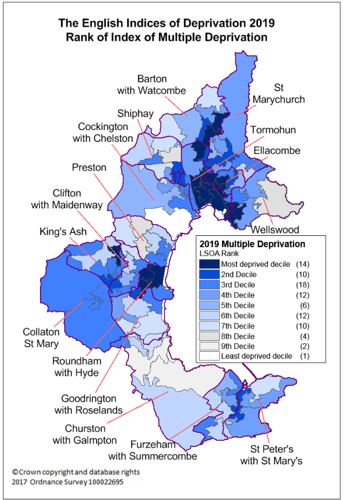
Source: Ministry of Housing, Communities and Local Government, www.gov.uk
Figure 1 shows - map of the distribution of deprivation across Torbay’s 87 lower super output areas (LSOAs) by decile:
- 14 LSOAs are in the most deprived decile
- 10 LSOAs in the second most deprived decile
- 18 LSOAs in the third most deprived decile
- 12 LSOAs in the fourth most deprived decile
- 6 LSOAs in the fifth most deprived decile
- 12 LSOAs in the sixth most deprived decile
- 10 LSOAs in the eighth most deprived decile
- 4 LSOAs in the ninth most deprived decile
- 1 LSOA in the least deprived decile
The most deprived areas are concentrated around the urban centres of Torquay, Paignton and Brixham.
Population overview
People in more deprived communities generally tend to experience multiple long-term conditions, have poorer health outcomes, and a shorter life expectancy. Disability free life expectancy measures the average number of years a person would expect to live without a long lasting physical or mental health condition or disability that would limit their daily activities, and in Torbay, healthy life expectancy for females has been significantly lower than England. For 2018 – 20, this implies that females in Torbay could expect to live for 20 years whilst not being in good health, for males it would be approximately 14 years. Healthy life expectancy is based on self-reported good or very good health from the Annual Population Survey and registered deaths.
Long-term conditions are those that cannot be cured but can be managed through treatment and behaviour. The Torbay GP registers show higher percentages of patients than in England as a whole, who have long-term conditions such as depression, diabetes, coronary heart disease, hypertension, asthma, chronic obstructive pulmonary disease (COPD), epilepsy and rheumatoid arthritis.
There are 139,479 people in Torbay (ONS Mid-Year Estimate 2022), and 1 in 4 are aged 65 or over (36,612 people, or 27%) which is higher compared to across England (where the 65s and over make up 18%). The population structure for Torbay is shown in Figure 2, and it clearly shows Torbay has higher proportions (blue bars) than the England average (black line) of residents in all age groups above the age of 50 and lower proportions for the younger age groups.
Figure 2: Population pyramid, Torbay (2022)
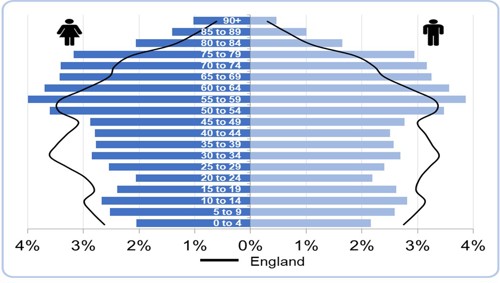
Source: Office of National Statistics (ONS) Mid-year estimate 2022
Figure 2 shows - Population pyramid of Torbay showing that the proportion of people aged 50 to 54 and older is higher than the national average. The proportion of people aged 45 to 49 and younger is below the national average.
The largest age group in Torbay is people aged 55 to 59 years. This is followed by people aged 60 to 64 years and then people aged 50 to 54 years.
Figure 3: Projected future population 2022-2043, Torbay
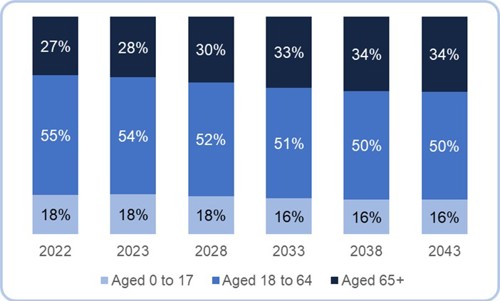
Source: NOMIS
| Age group | 2022 | 2023 | 2028 | 2033 | 2038 | 2043 |
|---|---|---|---|---|---|---|
| 0 to 17 | 18% | 18% | 18% | 16% | 16% | 16% |
| 18 to 64 | 55% | 54% | 52% | 51% | 50% | 50% |
| 65 and older | 27% | 28% | 30% | 33% | 34% | 34% |
By 2043, it is estimated that over one in three (34%) of Torbay’s population will be aged 65 years and over (52,033), compared to 24% across England. Population projections, by age group, are shown in Figure 3.
Two-thirds of adults aged over 65 are expected to be living with multiple health conditions (multi-morbidity) by 2035. Seventeen percent would be living with four or more diseases, double the number in 2015. One-third of these people would have a mental illness like dementia or depression. Multiple long-term conditions involves more healthcare professionals and transitions across specialties and healthcare boundaries, and there is correspondence with higher healthcare costs, unplanned or unnecessary hospital admissions, increased use of ambulatory care, delayed transfers of care and long-term institutionalization. It is likely with Torbay’s ageing population and higher rates of long-term health conditions that numbers with multiple long-term conditions are increasing in the Bay.
Also as our population ages, we expect the number of frail people, people with physical mobility, weakness, weight loss, slowness and or low physical activity to increase, specifically in our older age groups. The number of people with dementia is also expected to increase over the coming years. Estimates for the counts of frail people and those with dementia are presented in Figures 4 and 5.
Figure 4: Torbay Frailty estimates - Collard et al (2012)
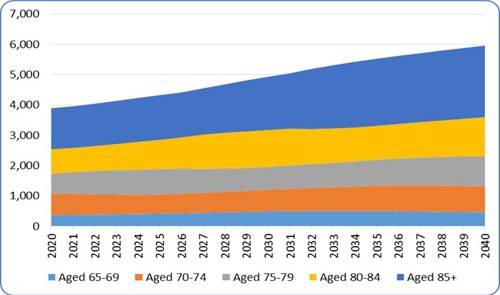
Source: ONS 2018 based population projections
Figure 4 shows - Chart of how frailty is projected to rise amongst all individuals aged over 65. The most significant rise is projected among those aged 85 and older, with numbers increasing from around 3,900 in 2020 to 5,900 by 2040.
Figure 5: Torbay Dementia estimates
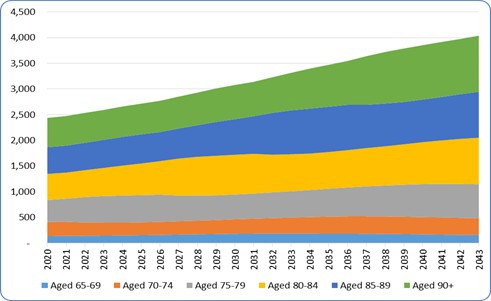
Source: Cognitive Function and Ageing Study (2013), ONS 2018 based population projections
Figure 5 shows - Chart showing that the number of people with dementia is projected to rise for Torbay’s population aged over between 2020 and 2045. The most significant rise is projected among those aged 90 and older, with numbers increasing from around 2,400 in 2020 to just over 4,000 in 2045.
Mental health includes our emotional, psychological, and social well-being. It affects how we think, feel, and act, and determines how we handle stress, relate to others, and make choices. One-in-four adults and one-in-ten children will experience mental illness during their lifetime. In Torbay, the prevalence of depression in primary care, the number of emergency hospital admissions for self-harm and recorded suicides, suggest levels of mental health needs are higher in comparison to the wider England average. Additionally people with mental health problems are more likely to experience poor physical health, and conversely people with poor physical health are at higher risk of experiencing common mental health problems.
Other issues affecting levels of need are prevalence of learning disability. A learning disability affects the way a person understands information and how they communicate. A learning disability can be mild, moderate or severe. Some people with a mild learning disability can talk easily and look after themselves, but take a bit longer than usual to learn new skills. Others may not be able to communicate at all, and have more than one disability. The percentage of GP patients known to have a learning disability is higher across Torbay compared to England. This could suggest higher levels of recognition within primary care. However, there are still estimated to be a noticeable number of persons with a learning disability not known to primary care.
Increasing demand
We know from the predicted changes in demography that the demand for health and social care services will also increase, however, we also know that local factors can influence (increase or decrease) the demand for adult social care (Professor John Bolton ‘Predicting and managing demand in social care, discussion paper’ April 2016, IPC - Institute for Public Care). The local factors are:
- The relative wealth or areas of high deprivation in the
- Behaviours of key players in the NHS, e. intermediate care and the availability of sufficient therapists and nurses in the community.
- How effective the council's ‘front door’ is at finding solutions for people and their
- The degree to which the assets of the person, their family and their local community are recognised and utilised in a person’s
- The effectiveness of short-term support and a preventive help approach, including the use of assistive technology and
- The practice and supervision of assessment and care management
- The degree to which people with long-term conditions are supported to maintain their independence and self-manage their conditions, including dementia care.
- The availability and vibrancy of the voluntary
- The availability, capacity and nature of supported housing services, including Extra-Care
- The partnership with carers and carer organisations; and
- Performance measures to assess how providers deliver outcomes for and positively impact the care
In addition to demographic pressures, changes in other service areas within the health and social care system impact demand for adult social care services.
With needs and demand for services rising, Torbay Council is working together closely with NHS partners to develop the health and well-being system, investing in intermediate care, specialist domiciliary care and alternative housing options with care. The Hospital Discharge programme remains an important and central part of Better Care Fund plans in Torbay. This should reduce stays and unnecessary placements of people in expensive forms of care and help them to recover and return home sooner.
The current data shows that the number of social care clients in residential and nursing care has risen over several years from approximately 680 to 780 and is currently remaining constant at about this level, allowing for the seasonal peaks over the Christmas period.
Figure 6: Long-term residential and nursing clients including full cost
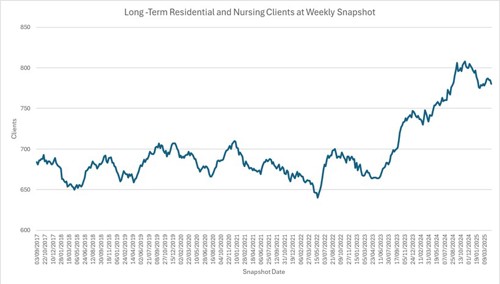
Source: TSDFT April 2025
Figure 6 shows - Chart of the evolution of the number of social care clients in residential and nursing care in Torbay from March 2017 to March 2025.
Data shows that the number of social care clients in residential and nursing care has risen over several years from approximately 680 to 780 and is currently remaining constant at about this level, allowing for the seasonal peaks over the Christmas period.
In April 2025 Torbay had about 780 social care clients (placed by TSDFT) in bed-based care against a registered capacity of 2,027 beds
(noting that not all these beds are usable), which suggests a significant proportion of beds are used by either self-funders and/or are commissioned by other local authorities (predominately purchased by Devon County Council as part of the Devon Wide System).
It is likely that we will see a downwards shift in demand for residential care to support low-level care needs and that the surplus of residential beds in the Bay will grow (unless some of these are re-purposed to support people with more complex needs e.g. dementia). However, whilst numbers are dropping, compared to other South West local authorities, and the England average, Torbay still has significantly more under 65s accessing residential care (Figure 7).
Also, whilst there are fewer under 65s accessing nursing care than other local authority areas (Figure 7), given increased dependency levels of service users and a shift from acute hospital beds to other community bed-based or community care and support options, this demand is predicted to rise.
Figure 7: Adults over the age of 65, Adult social care, short and long term support data
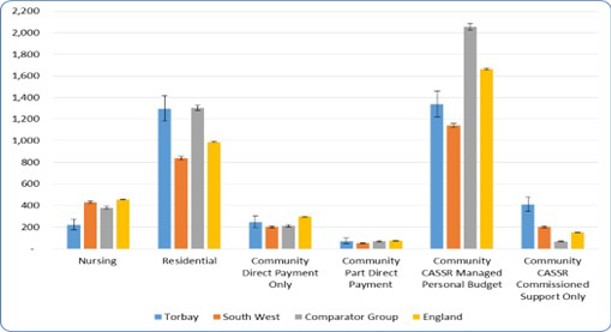
Source: NHS Digital
Figure 7 shows - Bar chart of adults aged over 65 in Torbay:
- In nursing care
- In residential care
- Receiving community direct payments only
- Receiving community part direct payments
- Receiving community personal budgets managed by Councils with Adult Social Services Responsibilities (CASSR)
- Receiving community CASSR commissioned support only
The bar charts compares adults aged over 65 in Torbay, the South West, a comparator group and England in receipt of the six care types. Fewer adults in Torbay are in nursing care than national and regional averages. More are in residential care and receiving direct payments than regional averages.
The demand for good quality bed-based care is recognised and so Torbay Council (working with NHS and providers) is planning to encourage the development of at least 200 more good quality care home beds for people with complex care needs by 2035. This will mean looking at both the beds in our existing nursing homes, identifying whether some beds within our residential care homes can be re-purposed to support people with more complex needs, and if required commissioning additional purpose-built new nursing homes/beds. This does not necessarily mean that the overall total number of care home beds in Torbay will increase, given the likely reduced residential care beds/homes supporting people with low-levels of care needs.
Torbay has significantly fewer over 65 clients accessing Council managed Personal Budgets than its comparator group, the England average, or the South West local authority average.
A key issue is that use of direct payments and personal budgets need to grow so that care homes placements are not used unnecessarily.
Figure 8: Clients receiving long term support during the year as per cent of the adult population aged 18 and over (2023/24) for All English unitary authorities.
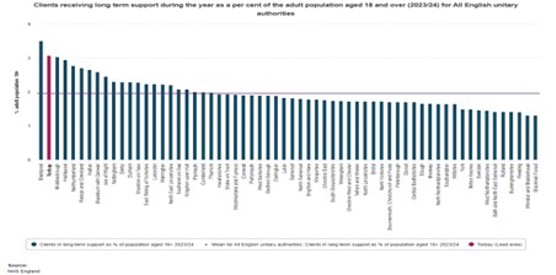
Source: NHS England
Figure 8, shows that Torbay has a significant variation for People aged 18+ years receiving long term support in the Torbay system. One of the key transformational pieces of work that we need to achieve is both a cultural and service change through commissioning to support more strength-based outcomes and practice.
Figure 9: Percentage of the population supported over time in Torbay with comparisons
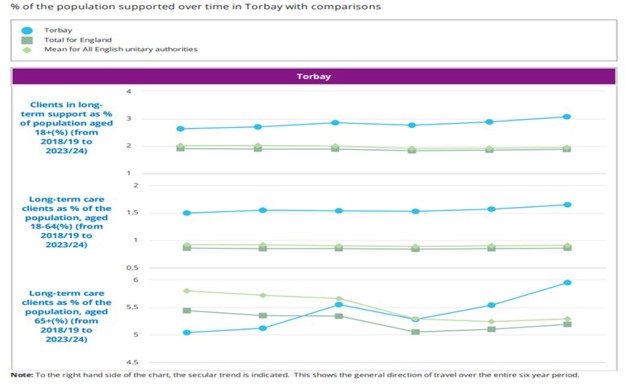
Figure 9 shows – line charts mapping the percentage of the population supported over time in Torbay with comparisons with total for England and mean for all English unitary authorities.
- Clients in long-term support as percentage of the population aged over 18 from 2018/19 to 2023/24: percentages for Torbay have been consistently higher than for England and English unitary authorities.
- Long-term care clients as percentage of the working age population (18 to 64) from 2018/19 to 2023/24: percentages for Torbay have been consistently higher than for England and English unitary authorities.
- Long-term care clients as percentage of the population aged over 65 from 2018/19 to 2023/24: percentages for Torbay were lower than for England and English unitary authorities from 2018/19 to 2020/21, but have risen since then. In 2023/24, percentages for Torbay were higher than for the comparators.
Figure 9 shows that this is reflected in wider system of Adult Social care in Torbay and as for working age adults, Torbay has significantly fewer clients accessing Council personal budgets and direct payments than other South West local authorities. Torbay also has a significantly lower number accessing direct payments than its comparator group, but more accessing personal budgets. (Figure 8).
Torbay has less under 65s accessing residential care than its comparator group, and significantly less than the South West and England averages.
Torbay has significantly higher request rates for support from under 65s than other South West local authorities or England average but the request rate is similar to its comparator group. (Figure 9).
Torbay actually had similar rates of requests for support from over 65s to that of other South West local authorities and the England average, as well as being lower than its comparator group. Although, in 2022-23, the rate of requests did sharply increase. (Figure 10).
Figure 10: Adults aged 18 to 64, Adult Social Care short and long term support data
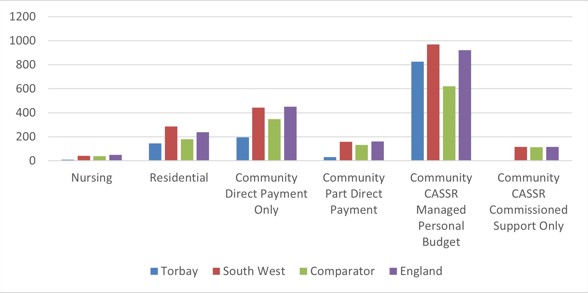
Figure 10 shows - Bar chart comparing the number of working age adults in six different care types across Torbay, the South West, a comparator group and England.
Adults aged 18 to 64 in nursing care:
- Torbay: 10
- South West: 41
- Comparator: 38
- England: 49
Adults aged 18 to 64 in residential care:
- Torbay: 145
- South West: 287
- Comparator: 181
- England: 237
Adults aged 18 to 64 receiving community direct payments only:
- Torbay: 195
- South West: 443
- Comparator: 348
- England: 450
Adults aged 18 to 64 receiving community part direct payments:
- Torbay: 30
- South West: 159
- Comparator: 132
- England: 160
Adults aged 18 to 64 receiving CASSR managed personal budgets:
- Torbay: 825
- South West: 970
- Comparator: 621
- England: 922
Adults aged 18 to 64 receiving community CASSR commissioned support only:
- Torbay: 0
- South West: 116
- Comparator: 113
- England: 117
Figure 11: Rate of requests for support received from new clients aged 18-64, per 100,000
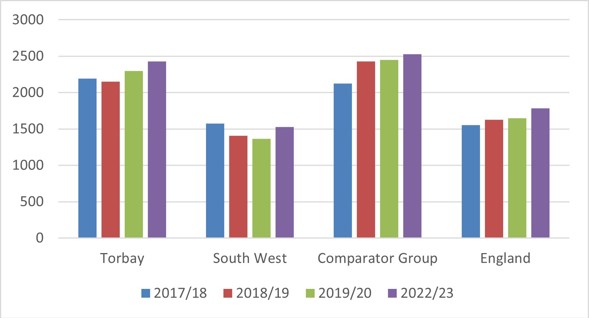
Source: NHS Digital, Adult Social Care Short and Long Term Support data, ONS midyear population estimates
Figure 11 shows - Bar chart comparing the yearly rate of requests (per 100,000) for support received from working age adults across Torbay, the South West, a comparator group and England.
2017/18 rate of requests for support received from new clients aged 18 to 64:
- Torbay: 2,195
- South West: 1,575
- Comparator: 2,125
- England: 1,555
2018/19 rate of requests for support received from new clients aged 18 to 64:
- Torbay: 2,150
- South West: 1,405
- Comparator: 2,430
- England: 1,625
2019/20 rate of requests for support received from new clients aged 18 to 64:
- Torbay: 2,300
- South West: 1,365
- Comparator: 2,450
- England: 1,650
2022/23 rate of requests for support received from new clients aged 18 to 64:
- Torbay: 2,430
- South West: 1,530
- Comparator: 2,527
- England: 1,785
Figure 12: Rate of requests for support received from new clients aged over 65, per 100,000
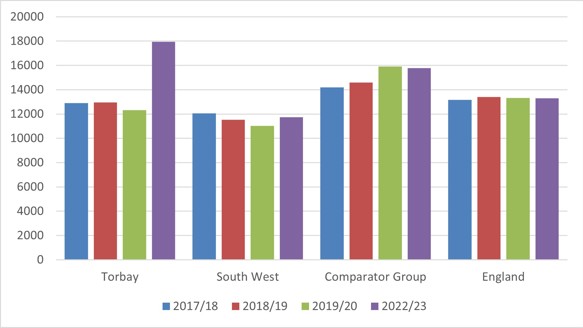
Source: NHS Digital, Adult Social Care Short and Long Term Support data, ONS midyear population estimates
Figure 12 shows - Bar chart comparing the yearly rate of requests (per 100,000) for support received from adults aged over 65 across Torbay, the South West, a comparator group and England.
2017/18 rate of requests for support received from new clients aged over 65, per 100,000:
- Torbay: 12,895
- South West: 12,065
- Comparator: 14,200
- England: 13,160
2018/19 rate of requests for support received from new clients aged over 65, per 100,000:
- Torbay: 12,950
- South West: 11,515
- Comparator: 14,600
- England: 13,400
2019/20 rate of requests for support received from new clients aged over 65, per 100,000:
- Torbay: 12,310
- South West: 11,015
- Comparator: 15,900
- England: 13,325
2022/23 rate of requests for support received from new clients aged over 65, per 100,000:
- Torbay: 17,955
- South West: 11,750
- Comparator: 15,772
- England: 13,285
For people aged 18 to 64 years who requested support in 2022-23, Torbay had:
- A higher rate accessing long-term care in the community, than its comparator group, the South West LAs but marginally lower than the England average;
- A significantly lower rate of people went on to receive ‘no services’, compared to elsewhere;
- An equal rate of people entering residential care to its comparator group, and a lower rate compared to other South West LAs and the England average;
- Provided less end-of-life care than other areas but still similar numbers
- Significantly higher rates of low-level support.
The increase in working age adults entering residential care is better illustrated in Figure 12 and the table below, which shows more than a fivefold increase in the last nine years.
| Year | Aged 18 to 64 |
|---|---|
| 2014/15 | 6 |
| 2015/16 | 16 |
| 2016/17 | 20 |
| 2017/18 | 22 |
| 2018/19 | 18 |
| 2019/20 | 24 |
| 2020/21 | 17 |
| 2021/22 | 27 |
| 2022/23 | 20 |
| 2023/24 | 33 |
Figure 13: Support request rate for new clients aged 18 to 64 years, by support type received, 2022/23
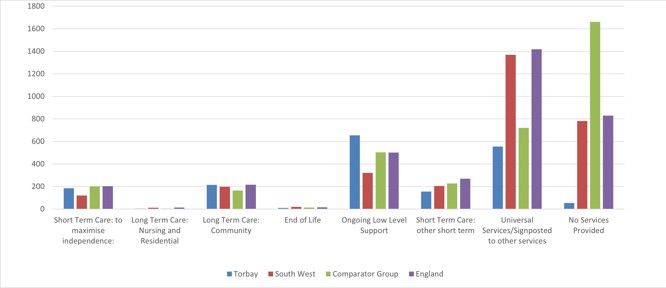
Source: NHS Digital, Adult Social Care Short and Long Term Support data, ONS midyear population estimates
Figure 13 shows - Bar chart showing the different support request rate from working age people received in 2022/23.
Request rate received for short term care to maximise independence from new clients aged 18 to 64:
- Torbay: 185
- South West: 120
- Comparator group: 202
- England: 204
Request rate received for long term nursing and residential care from new clients aged 18 to 64:
- Torbay: 5
- South West: 11
- Comparator group: 5
- England: 13
Request rate received for long term community care from new clients aged 18 to 64:
- Torbay: 215
- South West: 197
- Comparator group: 164
- England: 217
Request rate received for end of life care from new clients aged 18 to 64:
- Torbay: 10
- South West: 20
- Comparator group: 13
- England: 16
Request rate received for ongoing low level support from new clients aged 18 to 64:
- Torbay: 655
- South West: 321
- Comparator group: 504
- England: 502
Request rate received for other short term care from new clients aged 18 to 64:
- Torbay: 155
- South West: 205
- Comparator group: 228
- England: 269
Request rate received from new clients aged 18 to 64 who were signposted to universal/other services:
- Torbay: 555
- South West: 1,369
- Comparator group: 720
- England: 1,418
Request rate received from new clients aged 18 to 64 who received no services:
- Torbay: 55
- South West: 782
- Comparator group: 1,661
- England: 829
Figure 14: Number/rate of adults aged 18 to 64 moving into long-term residential care from other settings
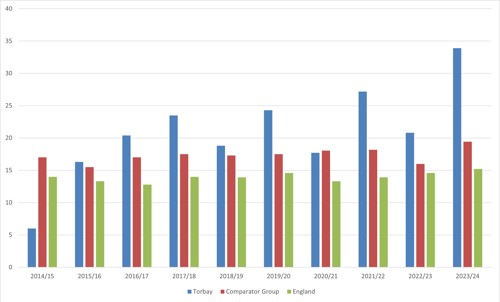
Source: NHS Digital, Adult Social Care Outcomes Framework
Figure 14 shows - Bar chart showing the yearly number/rate of working age adults moving into long-term residential care from other settings.
2014/15 number/rate of adults aged 18 to 64 moving into long-term residential care form other settings:
- Torbay: 6
- Comparator group: 17
- England: 14
2015/16 number/rate of adults aged 18 to 64 moving into long-term residential care form other settings:
- Torbay: 16.3
- Comparator group: 15.5
- England: 13.3
2016/17 number/rate of adults aged 18 to 64 moving into long-term residential care form other settings:
- Torbay: 20.4
- Comparator group: 17
- England: 12.8
2017/18 number/rate of adults aged 18 to 64 moving into long-term residential care form other settings:
- Torbay: 20.4
- Comparator group: 17
- England: 12.8
2018/19 number/rate of adults aged 18 to 64 moving into long-term residential care form other settings:
- Torbay: 18.8
- Comparator group: 17.3
- England: 13.9
2019/20 number/rate of adults aged 18 to 64 moving into long-term residential care form other settings:
- Torbay: 24.3
- Comparator group: 17.5
- England: 14.6
2020/21 number/rate of adults aged 18 to 64 moving into long-term residential care form other settings
- Torbay: 17.7
- Comparator group: 18.06
- England: 13.3
2021/22 number/rate of adults aged 18 to 64 moving into long-term residential care form other settings:
- Torbay: 27.2
- Comparator group: 18.18
- England: 13.9
2022/23 number/rate of adults aged 18 to 64 moving into long-term residential care form other settings:
- Torbay: 20.8
- Comparator group: 16
- England: 14.6
2023/24 number/rate of adults aged 18 to 64 moving into long-term residential care form other settings:
- Torbay: 33.9
- Comparator group: 19.42
- England: 15.2
For adults 65 and over who requested support in 2023/24, Torbay had:
- A significantly higher number accessing short-term care than in other councils in the South West, as well as England and the comparator group.
- A much lower number accessing nursing care than the South West average, slightly lower than the England average, but marginally higher than the comparator group.
- Less people access Residential care in Torbay than both the South West and England averages, though it is slightly higher than the comparator group.
- The numbers accessing long term care in the community are about on par with the comparator group and England, as well as being much lower than the South West average.
- Significantly fewer people receiving ‘no services’ than other South West local authorities, the England average, or its comparator group.
Figure 15: Support request rate for new clients aged over 65 years, by support type received, 2019/20
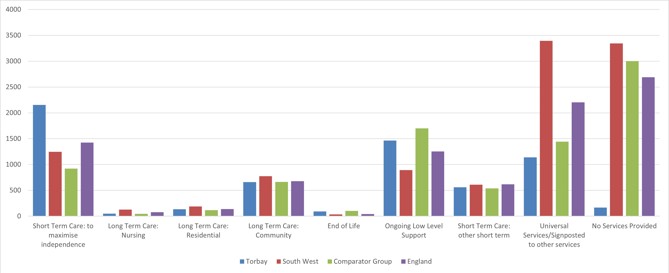
Source: NHS Digital, Adult Social Care Short and Long Term Support data, ONS midyear population estimates
Figure 15 shows - Bar chart of the different support request rates from people aged over 65 in the year 2019/20 in Torbay, the South West, a comparator group and England.
Request rate received for short term care to maximise independence from new clients aged over 64, 2019/20:
- Torbay: 2,155
- South West: 1,247
- Comparator group: 920
- England: 1,424
Request rate received for long term nursing care from new clients aged over 64, 2019/20:
- Torbay: 50
- South West: 126
- Comparator group: 47
- England: 76
Request rate received for long term residential care from new clients aged over 64, 2019/20:
- Torbay: 135
- South West: 188
- Comparator group: 117
- England: 137
Request rate received for long term community care from new clients aged over 64, 2019/20:
- Torbay: 660
- South West: 775
- Comparator group: 662
- England: 677
Request rate received for end of life care from new clients aged over 64, 2019/20:
- Torbay: 90
- South West: 35
- Comparator group: 102
- England: 42
Request rate received for ongoing low level support from new clients aged over 64, 2019/20:
- Torbay: 1,465
- South West: 892
- Comparator group: 1,700
- England: 1,254
Request rate received for other short term care from new clients aged over 64, 2019/20:
- Torbay: 560
- South West: 609
- Comparator group: 538
- England: 617
Request rate received from new clients aged over 64 who were signposted to universal/other services, 2019/20:
- Torbay: 1,140
- South West: 3,395
- Comparator group: 1,442
- England: 2,205
Request rate received from new clients aged over 64 who received no services, 2019/20:
- Torbay: 165
- South West: 3,343
- Comparator group: 3,000
- England: 2,690
For people 65 and over, although the number entering residential care was decreasing, it sharply increased after 2020.
Torbay had significantly lower rates of admission than its comparator group as well as the England average until 2021/22, see Figure 14.
| Year | Aged 65 and over |
|---|---|
| 2014/15 | 205 |
| 2015/16 | 176 |
| 2016/17 | 172 |
| 2017/18 | 158 |
| 2018/19 | 176 |
| 2019/20 | 189 |
| 2020/21 | 155 |
| 2021/22 | 287 |
| 2022/23 | 288 |
| 2023/24 | 289 |
Figure 16: Number/rate of adults aged over 65 moving into long-term residential care from other settings
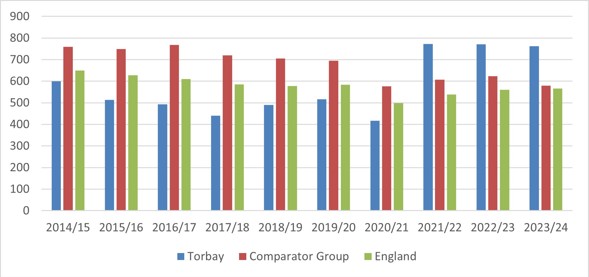
Source: NHS Digital, Adult Social Care Outcomes Framework 2A(2)
Figure 16 shows - Bar chart of the yearly number/rate of adults over 65 moving into long-term residential care from other settings across Torbay, a comparator group and England.
2014/15 number/rate of adults aged over 64 moving into long-term residential care form other settings:
- Torbay: 600
- Comparator group: 760
- England: 650
2015/16 number/rate of adults aged over 64 moving into long-term residential care form other settings:
- Torbay: 513
- Comparator group: 748.8
- England: 628.2
2016/17 number/rate of adults aged over 64 moving into long-term residential care form other settings:
- Torbay: 493.7
- Comparator group: 768.12
- England: 610.7
2017/18 number/rate of adults aged over 64 moving into long-term residential care form other settings:
- Torbay: 440
- Comparator group: 720
- England: 585.6
2018/19 number/rate of adults aged over 64 moving into long-term residential care form other settings:
- Torbay: 490.2
- Comparator group: 705
- England: 577.6
2019/20 number/rate of adults aged over 64 moving into long-term residential care form other settings:
- Torbay: 516.2
- Comparator group: 695
- England: 584
2020/21 number/rate of adults aged over 64 moving into long-term residential care form other settings
- Torbay: 417.3
- Comparator group: 576.3
- England: 498.2
2021/22 number/rate of adults aged over 64 moving into long-term residential care form other settings:
- Torbay: 772.7
- Comparator group: 607.88
- England: 538.5
2022/23 number/rate of adults aged over 64 moving into long-term residential care form other settings:
- Torbay: 771.6
- Comparator group: 622.96
- England: 560.8
2023/24 number/rate of adults aged over 64 moving into long-term residential care form other settings:
- Torbay: 762.3
- Comparator group: 579.28
- England: 566
Trends in key alternatives to bed-based care
Domiciliary Care
There are 32 providers of domiciliary care in Torbay and they each provide one domiciliary care service, although some may be registered to deliver services elsewhere as well. Currently we know that:
- 43% of Domiciliary care clients receive between less than 7 hours a week;
- 45% of Domiciliary care clients receive between 7 and 28 hours a week; and
- 12% of Domiciliary care clients receive over 28 hours a week and some of those receive over 56+ hours a week.
Use of domiciliary care has greatly increased over the last 7 years, with a corresponding increase in the monthly cost of packages, from £496k in January 2018 to £815k in December 2020 and more than doubling to £2,019,428 by February 2025.
Demand for services from self-funders
A self-funder is (typically) an individual who uses their own finances to pay for care (in both residential or community settings), as opposed to receiving support from the local authority or another third party.
Currently there is no requirement for local authorities or care providers to collect data on individuals who self-fund the care they receive, and so there is a significant gap in understanding the demand for services from self-funders. However, from the Office for National Statistics Census 2021 data some analysis has been done for England:
- From 1 March 2022 to 28 February 2023, there was a 3.1% increase in the number of care home residents (372,035) across England; of these 37% (137,480) were self-funders (a 9.2% increase in self-funders from the previous year (125,954).
- The South West region has the second highest proportion of self-funders (41.5%).
- The proportion of self-funders in care homes providing care for younger adults was 2.0%, which was statistically significantly lower than all other care home types. Care homes providing care for older people (aged 65 years and over) had a statistically significantly higher proportion of self-funders (48.9%) compared with the proportion of self-funders in all other care home types.
- Care homes with 1 to 19 beds had the smallest proportion of self-funders.
- In terms of care homes with ratings, care homes rated outstanding had the highest proportion of self-funders (50.9%). Care homes rated inadequate had the lowest proportion of self-funders (24.0%). The proportion of self-funders in the care homes decreased as quality rating decreased.
Supply
The Key points are:
- We need more services in the community that people can buy directly with a personal budget or direct payment;
- We do not have enough nursing home beds of sufficient quality if we compare ourselves with other authorities;
- We have an oversupply of residential care places in Torbay compared to similar local authorities, and the lower rates of placements into residential care suggests that self-funders and placements by other local authorities are significant in Torbay care homes;
- We would like more providers offering short breaks either in the community or in care homes – so that carers can take a break; and
- We would like more providers offering shorter services that aim to get people back home after a stay in hospital whether, in the community or in accommodation.
Care Quality Commission (CQC) registered care providers
Every month the CQC publish details of care providers in local authority areas which are a good source of data. Although the majority of Torbay care homes are CQC rated ‘good’ – 57 homes, compared to our CIPFA neighbours we have less rated ‘good’ on average – the average is 72.6 homes. Torbay does have less homes rated as ‘requires improvement’ – having 13 where the average of our CIPFA neighbours is 15. Torbay does also have marginally less homes rated as ‘outstanding’ having 2, where the average for our CIPFA neighbours is 4.
| Rating | Number of care providers | CIPFA average |
|---|---|---|
| Outstanding | 2 | 4 |
| Good | 57 | 72.6 |
| Requires improvement | 13 | 15 |
| Not rated | 9 | n/a |
Figure 17: Map of CQC registered care providers
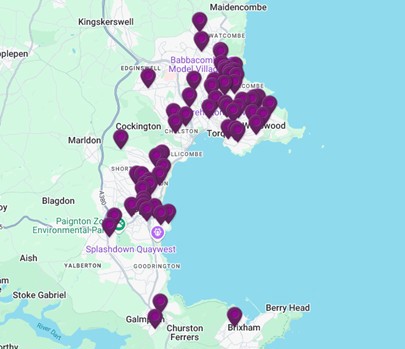
Source: CQC
Figure 17 shows - Map showing the distribution of the CQC registered care providers in Torbay.
In Torbay, as of March 2025, there are 64 residential care homes providing mainly care without nursing and approximately 1,350 usable beds within these settings. This is a net loss of six residential care homes since March 2020, with approximately 300 fewer beds. In addition, there were 13 nursing homes with approximately 500 usable beds (these figures have remained broadly static since March 2020).
Care homes without nursing:
The number of care homes and care home beds registered to each service user type, are shown in Figures 18 and 19.
N.B. Homes, providers and beds can be registered to more than one service user band so there are duplicates in these graphs.
Figure 18: Number of care homes without nursing registered to each service user band, Torbay, March 2025
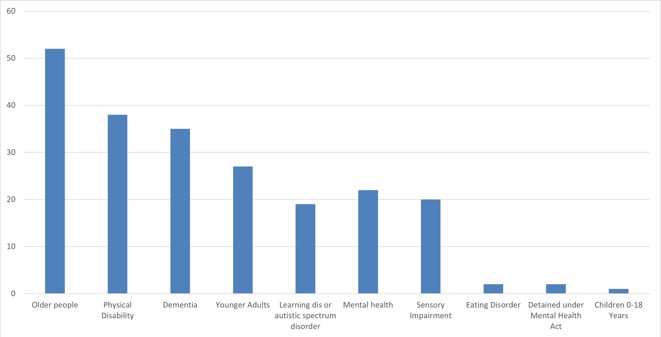
| Service user band | Care homes |
|---|---|
| Older people | 52 |
| Physical disability | 38 |
| Dementia | 35 |
| Younger adults | 27 |
| Learning disability or autistic disorder spectrum | 19 |
| Mental health | 22 |
| Sensory impairment | 20 |
| Eating disorder | 2 |
| Detained under Mental Health Act | 2 |
| Children aged under 18 | 1 |
Figure 19: Number of care homes beds without nursing registered to each service user band, Torbay, March 2025
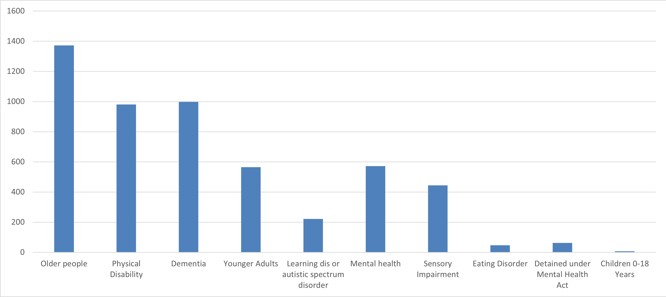
Source: CQC and TSDFT
| Service user band | Care home beds |
|---|---|
| Older people | 1,372 |
| Physical disability | 980 |
| Dementia | 997 |
| Younger adults | 565 |
| Learning disability or autistic disorder spectrum | 221 |
| Mental health | 572 |
| Sensory impairment | 444 |
| Eating disorder | 47 |
| Detained under Mental Health Act | 62 |
| Children aged under 18 | 7 |
Figure 20: Care homes without nursing registered to each service user band per 100,000, March 2020
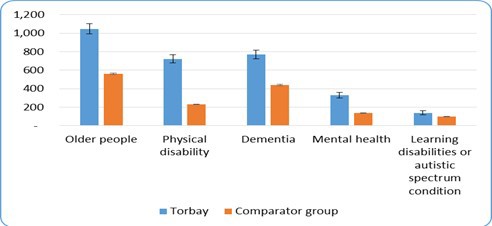
Source: CQC, TSDFT, and ONS 2018 Mid-Year Estimates. Analysis: Torbay Council
Figure 20 shows – Bar charts of the care homes without nursing registered to 5 different service user bands for Torbay and a comparator group for March 2020.
Torbay has more care homes registered to all 5 service user bands than the comparator group. The user bands are:
- Older people
- Physical disabilities
- Dementia
- Mental health
- Learning disabilities or an autistic spectrum condition
Figure 21: Care homes beds without nursing registered to each service user band per 100,000, March 2020
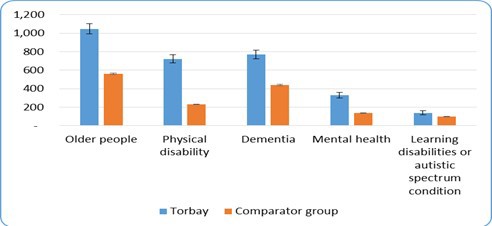
Source: CQC, TSDFT, and ONS 2018 Mid-Year Estimates. Analysis: Torbay Council
Figure 21 shows – Bar charts of the care home beds without nursing registered to 5 different service user bands for Torbay and a comparator group for March 2020.
Torbay has more care homes registered to all 5 service user bands than the comparator group. The user bands are:
- Older people
- Physical disabilities
- Dementia
- Mental health
- Learning disabilities or an autistic spectrum condition
In comparison with our CIPFA neighbours Torbay has:
- Almost double the amount of residential beds for older people;
- More than double the amount of residential beds for people with mental health issues;
- Three times as many beds for physically disabled people; and
- Almost double the amount of residential for people with dementia.
As well as reducing the surplus of residential beds for older people with low-level care needs, commissioners also want to reduce the usage of residential care for working- age adults, and in particular the number of adults with mental health issues placed in residential care.
Care homes with nursing:
In Torbay there are 13 nursing care homes providing 500 useable nursing beds, and they are registered by service user type as shown in Figures 22 and 23. In addition, other residential homes also provide some nursing care beds.
Note: Homes, Providers and beds can be registered to more than one service user band so there may be duplicates between columns.
Figure 22: Number of care homes with nursing registered to each service user band, Torbay, March 2020
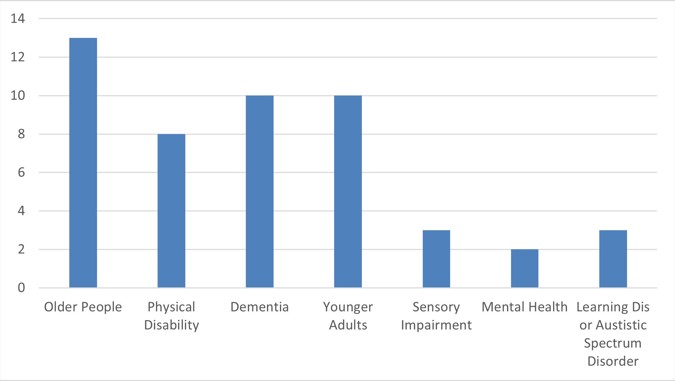
Source: CQC and TSDFT
| Service user band | Care homes |
|---|---|
| Older people | 13 |
| Physical disability | 8 |
| Dementia | 10 |
| Younger adults | 10 |
| Sensory impairment | 3 |
| Mental health | 2 |
| Learning disability or autistic spectrum disorder | 3 |
Figure 23: Number of beds of care homes with nursing registered to each service user band, Torbay, March 2020
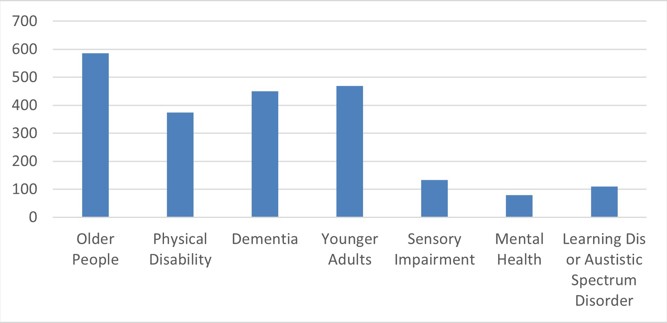
Source: CQC and TSDFT
| Service user band | Care home beds |
|---|---|
| Older people | 586 |
| Physical disability | 375 |
| Dementia | 450 |
| Younger adults | 469 |
| Sensory impairment | 133 |
| Mental health | 79 |
| Learning disability or autistic spectrum disorder | 110 |
Figure 24: Care homes with nursing registered to each service user band per 100,000, March 2020
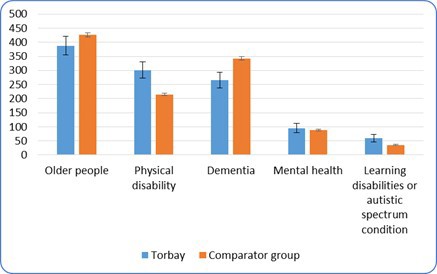
Source: CQC, TSDFT and ONS 2018 Mid-Year Estimates. Analysis: Torbay Council
Figure 24 shows – Bar charts of the care homes with nursing registered to 5 different service user bands for Torbay and a comparator group for March 2020.
Torbay has more care homes registered to 4 service user bands than the comparator group:
- Older people
- Physical disabilities
- Mental health
- Learning disabilities or an autistic spectrum condition
Torbay has fewer care homes than the comparator group registered to:
- Dementia
Our data shows that in comparison with our CIPFA neighbours Torbay has:
- Fewer nursing beds for older people;
- About the same amount of nursing beds for people with mental health issues;
- Significantly more nursing beds for physically disabled people; and
- Significantly fewer nursing beds for people with dementia.
As mentioned above, commissioners want to increase the number of nursing beds of greater quality by over 200, to meet the growing demand for complex care and nursing needs. Some of these places may be found within our existing wider care home bed capacity (as we look to reduce the number of surplus residential beds in Torbay that provide low-level (rather than complex) care needs), re-purposing supply to support people with dementia, and complex needs.
Services in the community
Domiciliary care services:
Figure 25 shows how many Domiciliary Care providers/services in Torbay are registered to each service user band, and as a provider may be registered to more than one service user band, there may be duplicates between columns.
Figure 25: Number of domiciliary care providers/services registered to each service user band, Torbay, March 2025
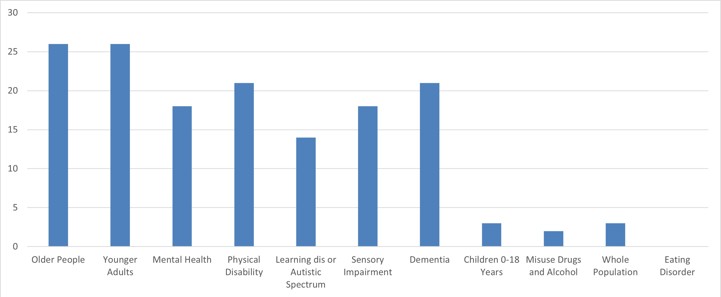
Source: CQC
| Service user band | Domiciliary care providers/services |
|---|---|
| Older people | 26 |
| Younger adults | 26 |
| Mental health | 18 |
| Physical disability | 21 |
| Learning disorder or autistic spectrum | 14 |
| Sensory impairment | 18 |
| Dementia | 21 |
| Children under 18 | 3 |
| Misuse of drugs and alcohol | 2 |
| Whole population | 3 |
| Eating disorder | 0 |
Figure 26: Rate of domiciliary care providers/services registered to each service user band, March 2020
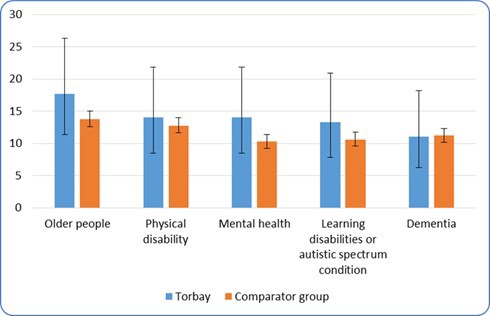
Source: CQC, ONS 2018 Mid-Year Estimates. Analysis: Torbay Council
Figure 26 shows – Bar charts of the domiciliary care providers/services registered to 5 different service user bands for Torbay and a comparator group for March 2020.
Torbay has more care homes registered to 4 service user bands than the comparator group:
- Older people
- Physical disabilities
- Mental health
- Learning disabilities or an autistic spectrum condition
- Dementia
Commissioners recognise that we can do more to keep people living as independently as possible for as long as possible, to help them ‘age in place’ and remain part of their community and within their natural ‘circles of support.’ To do this we need: more domiciliary and personal assistant services in the community, which also specialise in complex support, that people can buy directly, including with a personal budget or direct payment.
Supported living services:
Supported living is housing that is purpose designed or designated to provide support for a particular client group. The accommodation is often shared, but can be a single household. The one-to-one support is provided under separate contractual arrangement to those for the person’s housing.
There are 27 supported living providers in Torbay, registered as social care organisations and providing accommodation with support to over 250 people. About 70% of supported Living tenants are people with a learning disability.
Most providers are on the Torbay Supported Living Framework which facilitates referrals from practitioners through a vacancy register, and provides a focus on promoting people’s independence, quality of life, health and well- being. There remain four providers not on the Framework but working towards the same quality measures.
There are eight CQC registered supported living service providers which also provide personal care to people as part of the support that they need to live in their own homes. The personal care is also provided under separate contractual arrangements to those for the person’s housing. Supported living providers that do not provide the regulated activity ‘personal care’ are not required by law to register with the CQC.
We need to significantly increase supported living provision for people with learning disabilities, autism and mental health issues, both to enable people to leave residential care, and to divert people from entering it. During 2021/22 we re-opened the Framework to new providers, and also went out to our current providers, to develop this capacity. We want supported living providers to become more skilled at providing enabling support to people with complex issues and behaviours that challenge, increasing the person’s ability to self-regulate and always using the least restrictive practice.
Supported living and extra care increase self-determination, independence and citizenship, and enable people to be part of their community and develop natural circles of support.
Figure 27: Number of supported living providers/services registered to each service user band, Torbay, March 2025
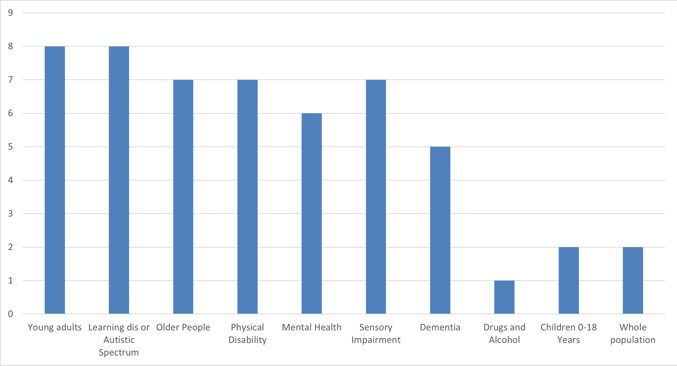
Source: CQC
| Service user band | Supported living services/providers |
|---|---|
| Young adults | 8 |
| Learning disorder or autistic spectrum | 8 |
| Older people | 7 |
| Physical disability | 7 |
| Mental health | 6 |
| Sensory impairment | 7 |
| Dementia | 5 |
| Drugs and alcohol | 1 |
| Children under 18 years | 2 |
| Whole population | 2 |
Extra care housing services
Extra care housing provides quality, safe and affordable housing with care and support which enables people to enjoy living independently, to build relationships and to live life to the full. People live in their own home, and there is on-site care and support staffing available 24/7 which flexes to individual needs, and may be provided on a continuous basis or only periodically.
In Torbay, extra care housing is not age-restricted and is available to anyone over the age of 18, who might have or develop ongoing care and support requirements and who would otherwise experience difficulties in other forms of accommodation.
There are currently 107 units of Extra Care Housing in Torbay, located over two sites and provided by one service provider who is registered as a social care organisation. The current residents include people with the following long-term conditions:
- Dementia;
- Learning disabilities;
- Autistic Spectrum Condition;
- Mental health issues;
- Physical disability; and
- Sensory impairment.
We are currently undertaking a capital project to deliver around 90 extra care homes in Paignton town centre, along with a new Day Centre. We are working on getting planning permission for this scheme in the first half of 2025.
There are also plans for a potential additional scheme in Torquay, to meet the projected demographic demand by 2030.
Extra care should enable people who need personal care and/or support to live as independently as possible in accommodation that is genuinely ‘their own’, and this is facilitated by separate legal agreements for the care/support provided and the accommodation.
Alternative care and support options
We want to build the market of alternative, more flexible options for people to buy care themselves with a personal budget or direct payment if they want to. This could be support with accommodation or support they receive in their own home. At the moment we have a small market of providers of support with accommodation, and providers delivering a variety of outreach and support options; largely providing services for people with learning disability, cognitive difficulties or mental health issues.
We would like to extend these options to more people, and to also develop greater consistency of quality, and a focus on measurable outcomes such as improving independence and wellbeing.
Personal assistants
Support Networks is a non-profit Torbay community project which specialises in matching enthusiastic, motivated personal assistants (PAs), to clients needing care in Torbay. The Support Networks Personal Assistant “matching" Service is free to those being funded in Torbay for their care and support and also free to all PAs.
The PAs on the Support Networks’ register all have the right qualifications, experience, and the following:
- An Enhanced DBS check (disclosure and barring system criminal records check);
- A RTW (Right To Work check in the UK);
- Proof of their employment status; and
- Public Liability Insurance.
However, PAs must also be able to work in a person-centred way, putting the client first, listening to their needs, hopes and goals. More details are at Supportnetworks.
A voluntary sector organisation (Disability Focus) helps local people with either employing and managing the payroll for a personal assistant/care worker who provides support to live independently, or help with paying of invoices. They were providing this service for 335 Torbay adults in March 2021, which is an increase on previous years.
| Time period | Number of clients |
|---|---|
| January 2016 | 178 |
| January 2017 | 194 |
| March 2021 | 335 |
Shared Lives services
Shared Lives South West supports adults with learning disabilities, autism, mental health issues and dementia by matching them with a carer. The aim is for the person being supported, to live the fullest life they can, be part of the community and maintain and promote new skills and independence. Carers are assessed and trained first, and then open their own family home to the person needing support.
It’s like adult fostering and an alternative to supported living and residential care.
In March 2025 it was supporting 26 adults funded through Adult Social Care. The Shared Lives South West organisation is rated ‘Outstanding’ by the CQC.
Community Equipment Services
The supply of specialist equipment can also help support people either in their own home or other accommodation.
Complex aids to daily living are provided through a Torbay Council contract. This equipment is provided on loan following an assessment from a Torbay and South Devon NHS Foundation Trust practitioner, and provides for people with short and long-term needs as well as end of life care.
Number of individual clients served
| Year | Number of people served |
|---|---|
| 2021/22 | 10,944 |
| 2022/23 | 10,852 |
| 2023/24 | 11,778 |
| 2024/25 | Tbc (awaiting data) |
Source: NRS
We need to give people the advice and information they need, as early as possible, to enable them to live as independently as they can, staying healthy and well for as long as possible.
Activities in the daytime
As of 24/04/2025, there are 215 people that use day services – a 3.37% increase from Spring 2020.The proportion of spend on people with learning disabilities is 75%, 18% on physical support and 7% other.
It is recognised that currently the quality of services provided, and outcomes delivered may vary significantly. From 2025 there will be a refreshment of day opportunities, including the development of a Day Activity/Day Service Framework for providers with clear outcomes, quality measures, cost settings and performance indicators.
| Time period | Number of people using day services and activities | Percentage spend on people with learning disabilities | Percentage spend on people with physical support needs |
|---|---|---|---|
| Summer 2016 | 258 | 72% | 15% |
| Spring 2020 | 208 | 74% | 18% |
| Winter 2024 | 214 | 79% | 13% |
| Spring 2025 | 215 | 75% | 18% |
More in About the council
- How the council works
- Councillors
- Leader of the Council
- Get in touch
- Voting and elections
- Consultations
- Finance and budgets
- Plans, policies and strategies
- Information and data
- Civic Mayor
- Pay an invoice
- Report fraud within or against the council
- Audit
- Achievements, Honours and Awards
- Climate Change
- Our Performance
- Greener Way for Our Bay